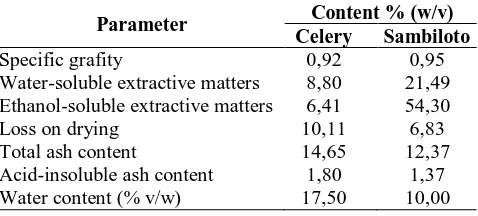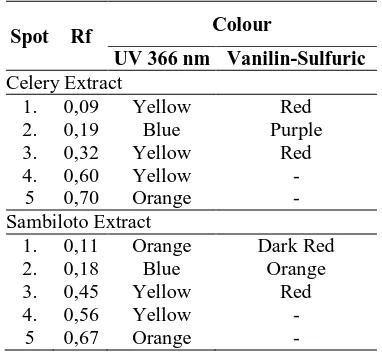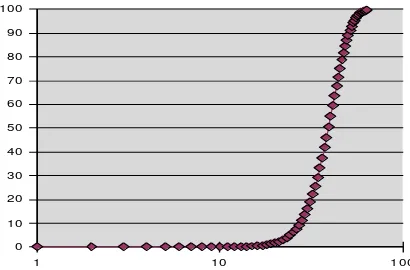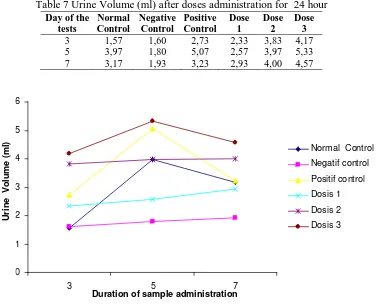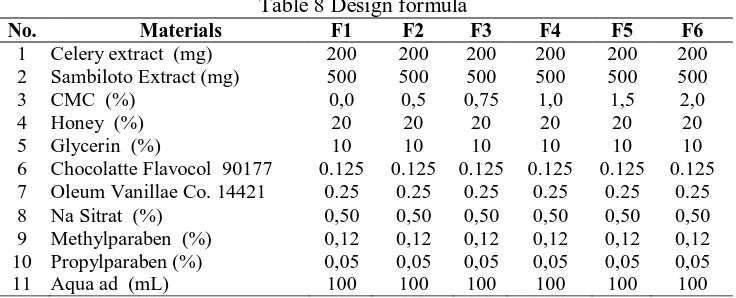International Seminar and Expo on Jamu ISEJ 2010 Bandung, Indonesia, 5-6 November 2010
DEVELOPMENT OF PHYTOPHARMACA PRODUCT CONTENT OF
COMBINATION OF EXTRACT CELERY (
Apium graveolens
L ) AND
SAMBILOTO (
Andrographis paniculata
Ness) AS MEDICINE
FOR NEPHROLITIASIS
Boesro Soebagio, Sohadi Warya, Taofik Rosdiana, Ade Zuhrotun
Faculty of Pharmacy Universitas Padjadjaran Indonesia *E-mail: [email protected]
ABSTRACT
Herbal Medicine has been accepted in all over the world, either in the developing country or developed country. According WHO report about 65% of population in developed country and 80% of population in the developing countrys use herbal medicine. Rising use of herbal medicine in developed countries might be due to increase of life expectancy when prevalent of chronic deseases increase, occurences of failures of medication of modern drug for certain deseases, and widespread of information about herbal medicine in the world. A study on ethanol extract of Celery (Apium graviolens L) and Sambiloto (Andrographis paniculata Ness) herbs was aimed at finding new alternative medicine for Nephrolitiasis. In Vitro preclinical test was carried out to examed solubilizing and dissolving capacity of the extract on calcium, magnesium and uric acid . While in vivo test was done by an induction method on hidroxyprolin on male mice. Formulation of the combination of the two extract to be a suspension dosage form was examined for its stability and quality. The results of the test on its activity the suspension dosage form of the extract effectively reduced nephrolitiasis at dose 2 (combination of sambiloto extract 500 mg/kg BW and celery extract 200 mg /kgBW mice). The dose 3 had faster onset of action and longer duration of action as compared with dose 1, dose 2 and control. Among all dosage forms, the formula with the concentration of CMC 1 % had better pH stability, particle diameter, viscocity, redispersiblity and significant effect on nephrolitiasis
Keywords: phytopharmaca, extract, and nephrolitiasis
BACKGROUND
Nefrolitiasis is a disease characterized by the formation of stones in the upper urinary tract (kidney stones). The main symptom of this disease is renal colic, low back pain, hematuria (bloody urine), and can cause complications of urinary tract obstruction. The compounds that play a role in these process are calcium oxalate/phosphate (60-80%), magnesium ammonium phosphate/struvit (10-15%), uric acid (5-15% ) and cystine. Handling medically in nefrolitiasis was done with surgery or laser that expensive in cost and still have any risks. Therefore, non-surgical treatments as an alternative was needed. A herbal medicine
using of celery plants (Apium graviolens L) and sambiloto (Andrographis paniculata Ness) are the choice of solution.
Mg. In vivo test with induced hidroksiprolin showed that infusion of celery (10, 20 and 30 mg/100 g BW mice) showed the effects of kidney stones dissolved were significantly (Irawaty, N., 1999). Other studies have reported that a combination of celery and sambiloto infusion shows the solubility Mg of kidney stones has increased threefold compared to the effects of one plant alone (Rusdiana, 1997). So that celery and sambiloto has considerable potential to develop as nefrolitiasis herbal drug.
METHODS AND RESULTS
Tools:
Sentrifugator, maserator, Spectroscopy Absorption Atom (Shimadzu-650), Spray Dryer, microscope, analytical balance, rat balance, viscometer, mixer, rotator and coomon apparatus in laboratory.
Materials:
Celery herb and sambiloto herb, include chemical kit for phytochemical sreening, toxycity and activity tests, and formulation to suspension. Toxicity test were used adult male and female mice (Swiss Webster strain, 20-25 g, aged 2 months). Activity tests were used male Wistar rats, 150-250 g, aged 2.5-3 months.
Sample preparation:
Materials was collected as dried sambiloto herbs from Research Agency of Spices and Medicinal Plants (BALITTRO), Bogor Indonesia and fresh celery herbs from farming land Ciwidey Bandung Indonesia. Both herbs were sorted, cleaned, air-dried then finally grinded. The plants were identified in Herbarium Jatinangor, Plant Taxonomy Laboratory of Biology Department, Faculty of Mathematic and Natural Sciences Universitas Padjadjaran. The result showed that the materials used were celery (Apium graviolens L) and sambiloto (Andrographis paniculata Ness).
Extraction was done by maceration for 3 x 24 hours of powdered herbs. The filtrate was collected and dried by spray drying process to obtain the extract powder. A 2,166 kg of celery extract was obtained from 4,5 kg crude drug (extractive matters= 76%). A 860 g of sambiloto extract was obtained
from 2,5 kg crude drug (extractive matters= 66%).
Determination of paramater quality
Extract were determined by strandard procedure [Depkes RI, 1987; 1995], parameters was covered water-soluble extractive matters, ethanol-soluble extractive matters, loss on drying, total ash content, water-soluble ash content, acid-insoluble ash content, and water content. Specifically to crude drug followed by macroscopical and microscopical analysis.
Macroscopical analysis showed that celery was green herb, stems and branches was short shaped, the leaves was composite, thin and brittle. It has a spicy taste and aromatic odour of celery. Powdered crude drug was brownish-green powder. The result of microscopic analysis of celery herb showed fragments of parenchyme, trachea, vessels filaments and secretory cells.
Sambiloto herbs in macroscopic analysis showed as dark green herbaceous plant, stems and branches was short shaped, a single leaf-lancet. This herb has a bitter taste but no smell. Powdered crude drug was brownish-green. The result of microscopic analysis showed fragments of upper and lower epidermis, mesophyll, vessels filaments, endosperm and stone cells from fruit leather. The result of determinations are available in Figure 1, Figure 2 and Table 1.
Table 1 Characteristic of Quality Extracts
Parameter Content % (w/v)
Celery Sambiloto
Specific grafity 0,92 0,95
Water-soluble extractive matters 8,80 21,49 Ethanol-soluble extractive matters 6,41 54,30
Loss on drying 10,11 6,83
Total ash content 14,65 12,37
Acid-insoluble ash content 1,80 1,37 Water content (% v/w) 17,50 10,00
Chemical Content Investigation
monoterpen & sesquiterpen, triterpenoid, steroid, and quinone, using standard procedures (Depkes RI, 1995). The results are available in Table 2.
Table 2 Result of Phytochemical Screening
Secondary metabolite Celery Extract
Sambiloto Extract
Alkaloid - -
Flavonoid + +
Tannin and Polyphenol - +
Saponin - -
Monoterpen & Sesquiterpen + -
Triterpenoid - -
Steroid - -
Quinone + +
Note: (+ ) = Present ( - ) = Absent
Ethanol extract of celery and sambiloto were investigated by Thin Layer Chromatography (TLC) using precoated silica gel GF254 and (3:3) mixture solvent of ethyl acetate:chloroform. Chromatogram was observed under UV 366 nm and after sprayed by 10% of vanillin-sulfuric acid (V-S), revealed the profile or numerous chemical
contents of both extracts marked by every spots. The results showed in Table 3.
Tabel 3 Chromatogram of TLC
Spot Rf Colour
UV 366 nm Vanilin-Sulfuric
Celery Extract
1. 0,09 Yellow Red 2. 0,19 Blue Purple 3. 0,32 Yellow Red
4. 0,60 Yellow -
5 0,70 Orange -
Sambiloto Extract
1. 0,11 Orange Dark Red 2. 0,18 Blue Orange 3. 0,45 Yellow Red
4. 0,56 Yellow -
5 0,67 Orange -
Toxycity tests:
Toxycity tests in this research was acute toxycity test conducted by Weil method to provided LD50 value. This value used as parameter indicated toxycity of substances. Increasing value of LD50 showed that the substance less toxic. Toxicity test results can be seen in Table 4, Table 5 and Figure 1.
Table 4 Response of Mortality to Dosage
Group Treatment Total
Mencit
Mortality of Mencit (%)
Hour 1 hour 2 hour 4 hour 24 Day 7 Day 14
control PGA suspensions 10 0 0 0 0 0 0
I 25 g/kg BW 10 0 0 0 0 0 0
II 30 g/kg BW 10 0 20 20 20 20 20
III 36 g/kg BW 10 50 50 50 50 50 50
IV 42 g/kg BW 10 30 60 60 60 60 60
From data in Table 4 showed that mortality began at the dose of 30 g/kg BW and increasing doses allowed increased mortality of mice. It can be observed that at some doses of longer observation time more mice died.
Based on data processing with BMDS software using log-probit function obtained that LD50 value of combination extract of celery and sambiloto orally in mice was at 38.31 ± 2.48
g/kg BW. This value is more than 15 g/kg BW, so that the combination of both extract considered practically non toxic.
Table 5 Parameter Estimates
Variable Estimate Std. Err.
Background 0 NA
Intercept -14.6344 4.73837
Figure 1 Mortality response to log dosis
Doses that used was based on preliminary test on the dose (g/kg BW) of 9, 18, and 36 using 3 mice. In preliminary tests found that death occurred at dose of 36 g/kg BW, so the dose that causes death most likely at doses above 18 g/kg BW. By using this asumption, doses range was composed of acute toxicity test. Each group was given substance at doses increased by a multiple fixed factor. It was expected that increasing doses proportionally will increases animal respons. Multiple fixed factor would obtained a straight line when plotted the percentage of animals respons as a function of log dose. Comparative value or multiple fixed factor in each doses was 1,2.
In general, celery classified as non toxic herb. In the list of Food and Drug Administration, celery is considered not toxic and generally safe for consumption. Previously reserches
showed that there’s no dangerous health risks
when celery herb used in accordance with therapeutic doses (infusion 1 g of celery herb per day).
As additional parameters of acute toxicity test, was done an observation of body weight of
mice and behavior (pharmacological screening blind). It were intended to find out drug respons profile of animals. The results revealed that there were no significant differences in body weight of mice as the effect of dose administered.
Pharmacological test
Pharmacological test of combination extracts of celery and sambiloto herbs was conducted in two stages, in vitro and in vivo tests. Results from each tests will be used as scientific evidence about activities of both extracts.
a. In Vitro Test
A powder of kidney stone componens was tested on its saturation solubility in the liquid extract at various concentrations. Determination was measured by AAS method. The liquid extract which gives the best results then tested using dissolution tester.
The difference levels of Ca and Mg dissolved in media pH 3.5 and aquades can be seen in Figure 2. It appears that the average levels of Ca and Mg dissolved in media pH 3.5 is greater than in aquades. These results prove that Ca and Mg of kidney stones dissolved optimal acid media. Dunnett test was done to see the best solubility of each concentration. The results showed that in media 3.5, liquid extract 1% of concentration was the best concentraion to dissolve Ca and Mg of kidney stones (Figure 2 a). In aquades, liquid extract 3% of concentration was the best concentraion to dissolve Ca, while and liquid extract 2% and 2,5% of concentration was the best concentraion to dissolve Mg (Figure 2 b).
1 10 100
Kadar Ca dan Mg
542.635 511.627
472.868
418.604 527.131 728.682
187.305 162.414
160.547 174.859 182.327
326.073
0 100 200 300 400 500 600 700 800
1% 1,5 % 2% 2,5 % 3% (Kontrol)
Konsentrasi
K
ad
ar
(
p
p
m
)
Ca (ppm) Mg (ppm)
(a)
Kadar Ca dan Mg
0.312 3.906
3.125 0.781
5.781 4.14
26.565 88.363
90.852 90.852
61.605 64.7168
0 10 20 30 40 50 60 70 80 90 100
1% 1,5 % 2% 2,5 % 3% (Kontrol)
Konsentrasi
K
ad
ar
(p
p
m
) Ca (ppm)
Mg (ppm)
(b)
b. In Vivo Test (Hydoxyroline-Induced Method)
In vivo test was done at followed condition: Animal test used were 24 Rats, male, Wistar induced with Hydoxyproline (except group 6). After 48 hours rats treated with sample (as determination, with specific preparation, was done by atomic absorption spectrophotometer (AAS) to analize the crystal components in urine and kidneys.
The goups of rats:
1. Normal control: untreated
2. Negative control: given a 2% suspension of PGA
3. Positive control: given product innovator 4. Dose 1:given combination extract of celery
and sambiloto 1:1 (100 mg: 500 mg/kg BW)
5. Dose 2:given combination extract of celery and sambiloto 1:2 (100 mg: 1000 mg/kg BW)
6. Dose 3:given combination extract of celery and sambiloto 2:1 (200 mg: 500 mg/kg BW)
Ratio of weight kidney to rat:
This study was done to observe whether Hydoxyproline induced intraperitoneally were successful to form calcium stones in the kidneys. The results obtained in Table 6.
Data were analized with analysis of varian (ANOVA). The results showed that value of Fcalculation > F0,05 (5,12) indicated that H0 was
rejected, which means that there were
significant differences in the ratio of weight kidney to rat in each six treatment groups (5% of significance level).
Newman-Keuls was done to observe which groups were different. The results showed that negative control was significantly different to with the five other groups. Induction of Hydoxyproline intraperitoneally will form calcium stones in the kidneys so that will add weight to kidneys and thus to ratio of weight kidney to rat. The largest ratio value in negative control because there was no medication or treatments after induction, the rats in this group was only given Hydoxyproline as induction agent. This can be concluded that induction with Hydoxyproline intraperitoneally has managed to form calcium stones in the kidney.
Rat urine analysis:
To determine whether the concentration of Ca in rats affected by experiment doses of combinaton both extract, then conducted urine analysis using AAS. Urine sample was collected for 24 hours at day-3 of the tests.
From previous researches known that sambiloto has a diuretic effect and cerely was empirically used to diuresis. This invention supported by this research that can be seen in urine volume was collected at day 3, 5, and 7 of the tests (Table 7). Data in Table 7 showed increased in urine volume during the tests and dose 3 has the largest urine volume. It imply that doses increses will indicate the increasing output of urine volume.
Data can be created in graphical form as followed. Figure 3 shows the relationship between urin volume for 24 hour to the duration of the sample administration (day tests). Sambiloto and celery have a compound that may shed stone of Ca and by the effects of diuresis helps the calcium stones release. So the combination extract of celery and sambiloto were synergistic in destroying kidney stones (Figure 4).
Table 7 Urine Volume (ml) after doses administration for 24 hour Figure 3 Urine volume for 24 hour to duration of sample administration
Figure 4 Concentration Ca in urine volume for 24 hour to duration of sample administration
Formulation and Development of Pharmaceutical Dosage form
Pharmaceutical dosage form of combination extract of celery and sambiloto was suspension. The production of this suspension in laboratory scale were used the standard procedure as followed. All materials are
weighed according to the designed formula (Table 8). In mortar, CMC as suspending agent was developed until homogeneous then the ctive ingredients were gradually dispersed. Glycerin was added while slowly stired to assist the wetting process so that suspension reached quickly. Other additional ingredients
0
Duration of sample administration
C
Duration of sample administration
added after the emulsion formed. Evaluation of product was carried out by organoleptic, pH, viscosity, particle diameter, sedimentation volume, redisperse-ability, and flow rates.
Determination of the best formula:
Data that can be used as parameters to determine the best formulas are pH, particle diameter, viscosity and redisperse-ability. This is because the other parameters of organoleptic and flow rates showed no significant difference. These results founded out a best
formula that is F4 with CMC concentration of 1% due to showed the stability of pH, particle diameter, viscosity and a better redisperse-ability.
Pharmacological study using F4 as sample in induced- Hydoxyproline method showed that formula have significantly destroying of kidney stones as compared with a negative control and a product innovator.
Table 8 Design formula
No. Materials F1 F2 F3 F4 F5 F6
1 Celery extract (mg) 200 200 200 200 200 200 2 Sambiloto Extract (mg) 500 500 500 500 500 500
3 CMC (%) 0,0 0,5 0,75 1,0 1,5 2,0
4 Honey (%) 20 20 20 20 20 20
5 Glycerin (%) 10 10 10 10 10 10
6 Chocolatte Flavocol 90177 0.125 0.125 0.125 0.125 0.125 0.125 7 Oleum Vanillae Co. 14421 0.25 0.25 0.25 0.25 0.25 0.25 8 Na Sitrat (%) 0,50 0,50 0,50 0,50 0,50 0,50 9 Methylparaben (%) 0,12 0,12 0,12 0,12 0,12 0,12 10 Propylparaben (%) 0,05 0,05 0,05 0,05 0,05 0,05
11 Aqua ad (mL) 100 100 100 100 100 100
DISCUSSIONS
Examination conducted to determine the quality of the extracts by parameters of standardized extract (Table1-3). At this stage also performed makroscopic and microscopic analysis. Table 2 showed that in the extract of celery and sambiloto herbs has minimal 5 compounds. Each of these compounds are similar in Rf values and colors, so it were indicated that both extracts contained similar compounds. Phytochemical results (Table 3) showed that both extracts have flavonoids and quinones. While tannin and polyphenol were only detected in extract of sambiloto herb and mono and sesquiterpenes were only detected in extract of celery herb.
Toxycity tests results in Table 4 treated with Dunnet method was provided LD50 value at 38.31 ± 2.48 g/kg BW, which showed that both extracts practically non toxic. Futhermore, Dunnet methods was done to see the power of dissolving the Ca and Mg from the extract with various concentrations (Figure 2). While the test results in vivo (Figure 3 and Figure 4) showed that celery and sambiloto have compounds that can shed calcium stones. So
the combination of celery and sambiloto are synergistic in destroying kidney stones.
The test results at formulation stages shows that the best formula is F4 which is a formula obtained with a concentration of 1% CMC as indicated the stability of pH, particle diameter, viscosity and redispersibilitas ability. Formula F4 have significantly destroying of kidney stones as compared with a negative control and a product innovator.
CONCLUSIONS
SELECTED REFERENCES
Departemen Kesehatan Republik Indonesia. 1987. Analisis Obat Tradisional. Jakarta: DepKes RI, Direktorat Jenderal Pengawasan Obat dan Makanan. hal. 1-2.
Departemen Kesehatan Republik Indonesia. 1995. Materia Medika Indonesia. Jilid VI. Jakarta: DepKes RI, Direktorat Jenderal Pengawasan Obat dan Makanan. hal. 319, 321, 323-325.
Irawaty, N., 1999, Aktivitas Infus Campuran Sambiloto (Andrographis paniculata Ness.) dan Seledri (Apium graveolens L.)
pada Batu Ginjal Tikus dengan Metode Induksi, [SRKIPSI], Jurusan Farmasi, Fakultas Matematika dan Ilmu Pengetahuan Alam, Universitas Padjadjaran, Jatinangor.
